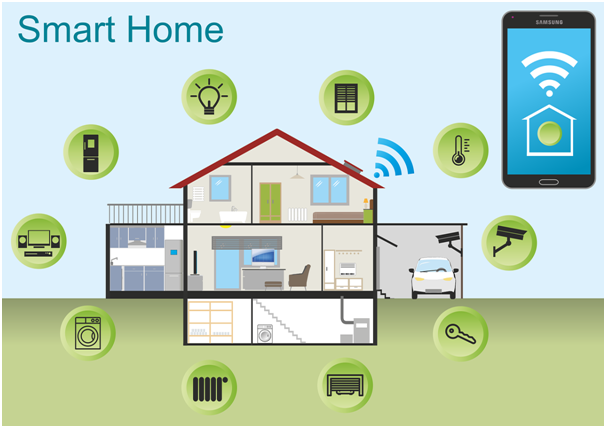We live in an age of convenience and automation. If we don’t evolve with the times, we’ll be outrun by those around us, holding us in an old-school world. With artificial intelligence (AI) becoming an integral part of our lives, it is practically impossible to think of a life without it. Smart hubs are an example of AI that helps to our run our day-to-day lives smoothly and conveniently.
Smart hubs are a software or hardware that connect and control the device’s communication on an automation network. They can connect to the cloud or locally to Internet-of-Things (IoT) devices using the Zigbee, Z-Wave, or Bluetooth protocols, instead of the Wi-Fi. These can be sometimes known as smart bridges too, which collect and translate communications from various smart devices.
Home Automation Smart Hubs

While there are all sorts of smart hubs, our focus is on those used primarily for home automation. As a master controller of home automation, the smart home hub can divert traffic from the Bluetooth or Wi-Fi protocols, easing the network’s congestion.
However, there are times when a well maintained smart hubs breaks down eventually which can cause a lot of frustration to you as you won’t be able to use those smart devices and appliances. In that case, the best option would be to acquire services from home warranty companies like First American Home Warranty, which will send their technicians immediately to your home to repair, diagnose or replace the damaged devices. In short, these home warranties companies protects your household smart appliances and devices.
The best smart hubs for homes must be able to do a plethora of things to make life convenient for us. Simply put, a smart home hub is a tech that gets all your smart tech working seamlessly and together.
The following are features that help to categorize the functionality of such hubs:
One Smart Device To Control All Smart Devices
There are many advantages of having one smart hub to control all the smart appliances and devices in the house connected via high speed broadband. Some examples of this include the Harmony, Samsung SmartThings, and Wink. These hubs are supposedly meant to work seamlessly with all software and protocols that all other devices work on, enabling you to control everything from a single app.
However, there’s one glaring disadvantage. Many smart home ecosystems like the LightwaveRF, Philips Hue, and Hive come with their very own hubs as they run on Zigbee, Z-Wave, or other such protocols. Such devices would need their hub to control them. Therefore, if you have invested in a hub like Samsung’s SmartThings, it doesn’t guarantee that all your smart devices will respond to it.
You will still require their hubs to run those ecosystems. In such a scenario, you have to juggle between multiple ecosystems and hubs to get them doing their respective jobs. Alternatively, if you have smart, voice-automated hubs like the Amazon Echo and the Google Home-Max, all your other hubs and ecosystems are practically rendered useless. Now that’s not very convenient, is it?
Smart Speakers For The Smart Home
Smart, voice-automated speakers like the Google Home-Max and the Amazon Echo are brilliant and convenient to have around. With these speakers, you can voice control multiple other ecosystems. A smart device that was bought earlier on can be connected with smart speakers, enabling the voice control of that particular device. So while the hardware of these smart hubs can communicate with other devices using its Z-Wave or Zigbee protocol, its software would barely feel the difference.
This technology is not without its flaws, nonetheless. Just like the dedicated hubs, smart speakers cannot communicate directly if the ecosystems don’t use Wi-Fi. That is, if your thermostats, bulbs, cameras, and other appliances have its hub that doesn’t use Wi-Fi, then your Home Max or Echo will be a wasted investment. So, in the case of the Echo Plus, because it comes with its Zigbee hub, it can find devices like the Philips Hue and control it. But the control will be minimal and will restrict to the basic on, off, and brightness management.
No Need Of Hardware Hub; Software Hubs Will Do
The best advantage of software hubs is that you would not need to buy new pieces of smart home hardware every time you buy a device. Many apps can do the job in a few, simple clicks.
It completely nullifies the need to unify all the different devices to their many hubs. Your smartphone becomes a one-stop-shop for all the devices, provided they can connect with an app and let it control them. This is the most advantageous feature of such smart software hubs.
The following are some software hubs that can work perfectly with a plethora of devices:
- Stringify,
- Yonomi,
- Wink,
- Elgato EVE.
If you have decided to purchase a smart home hub for convenient living, you should be wary of the following factors before making your purchases.
Connectivity Matters
Do your research before you invest. Before buying a smart home hub, you must know if the one you intended to buy can interact with and control your existing devices. Different companies design all smart ecosystems and, hence, they respond to different languages or protocols. That means that their compatibility may be limited to specific hubs only. Furthermore, when shopping for a smart hub it is important to check that your internet connection is strong enough to support your devices. If not, then it might be worth switching to a different internet service provider. You can learn more about how to do this by comparing internet packages from ISPs such as Xfinity internet to name just one example.
So, it is advisable that you buy a hub with uniform sensors, which can be used in your home to interact with all the smart products. These include appliances, security systems, thermostats, door locks, lights, fans, garage doors, etc.
Hubs With Open Software Apps
The other option for you is to opt for a smart hub that has an open software app. It will allow the devices’ software to be written to enable their connectivity with hubs that are not their own.
When looking for hubs with the open software application, search those that can support a good range of protocol types using various radio waves. Cloud-based hubs are also an option as they enable communication with multiple devices.
Don’t Ignore The Protocol Types
Smart home hubs mainly feature four kinds of protocols. They are the more common ones, Wi-Fi and Bluetooth, and the rarer ones Z-Wave and Zigbee.
Wi-Fi is fundamentally used for Internet purposes. They are now, however, being used for smart home devices too. Because it is a high bandwidth entity, it consumes good amounts of battery power.
Therefore, the best way to use hubs with Wi-Fi is to keep them plugged into an electric source, ensuring a constant supply of power.
Bluetooth uses radio frequency that jumps and encrypts to assure a secure transmission. Its bandwidth is lower than that of the Wi-Fi and is more flexible about what it can receive and send. It also has the Bluetooth L.E version, where “LE” denotes “Low Energy.” This Bluetooth uses much less power and is a preferred choice.
Z-Wave and Zigbee are similar and use mesh networks. Although they use little power, they are not the best options simply because of the limited devices that use these techs. They are better suited for simpler devices like motion sensors and light bulbs. Also, they are incompatible with phone apps and need the Ethernet cable to connect a Wi-Fi network.
Conclusion
Choosing a smart home hub requires some homework. Of course, it all comes down to the specific requirements expected with the system. To make such a decision, you will need to explore the various features discussed above thoroughly.

